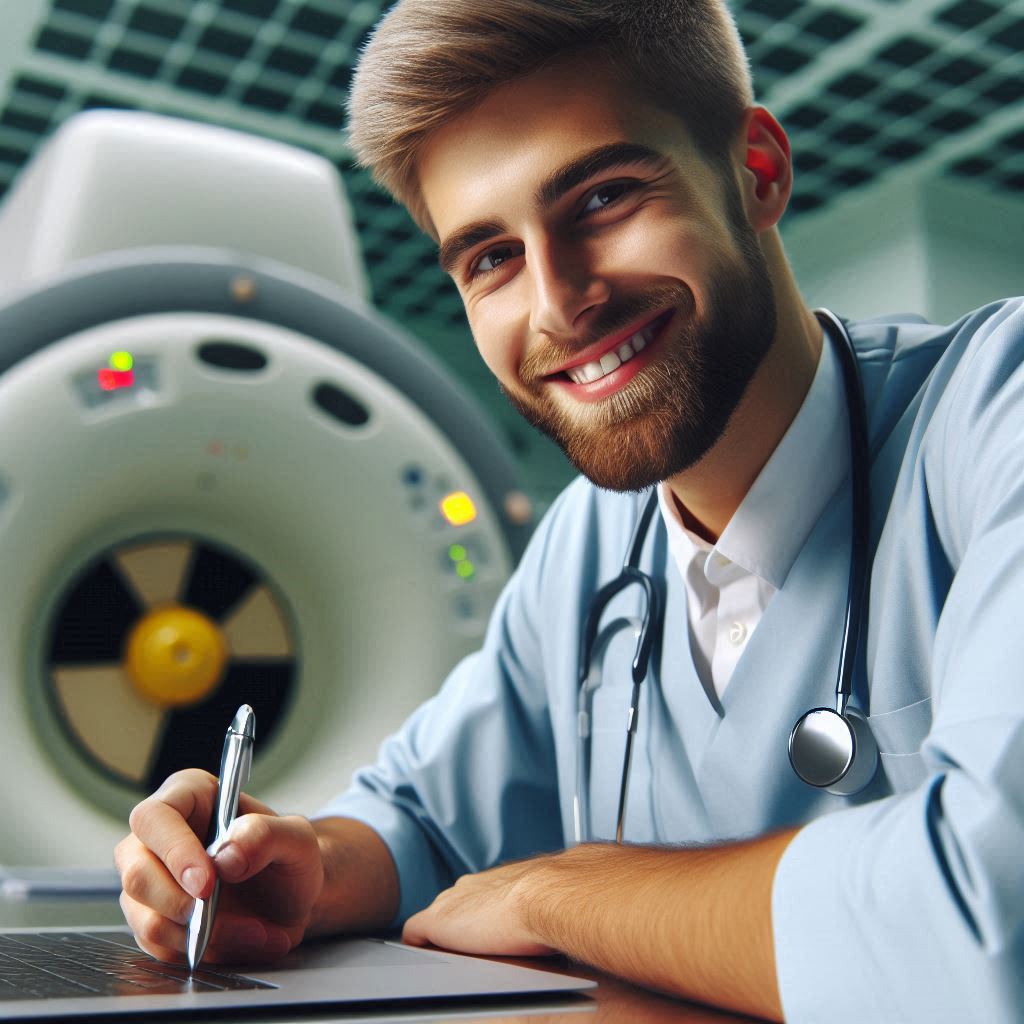Introduction
In this blog post, we will explore Nuclear Medicine Tech Safety Measures.
Nuclear medicine plays a crucial role in medical diagnostics and therapy, using radioactive substances.
A nuclear medicine technologist is responsible for administering these substances to patients and operating imaging equipment.
It is paramount to adhere to safety protocols in nuclear medicine to protect both patients and staff.
Adhering to Safety Procedures
Before procedures, verify patient identification and medical history to ensure correct dosage.
Handle radioactive materials with care, using proper shielding and protective equipment at all times.
Proper disposal of radioactive waste following established protocols is essential to prevent contamination.
Regularly monitor radiation levels in work areas to ensure safety standards are maintained.
Patient Safety Measures
Explain procedures to patients, obtain informed consent, and address any concerns regarding radiation exposure.
Follow strict protocols to minimize radiation exposure to patients during diagnostic imaging procedures.
Monitor patients post-procedure for any adverse reactions or side effects to promptly address any issues.
Staff Protection
Provide ongoing training for staff on radiation safety, emergency procedures, and proper handling of radioactive materials.
Encourage the use of dosimeters to monitor individual radiation exposure levels among staff members.
Implement a culture of safety in the workplace by promoting awareness and adherence to safety guidelines.
Importance of Proper Training
The need for nuclear medicine technologists to undergo extensive training in radiation safety
Proper training is essential for nuclear medicine technologists to ensure the safe handling of radioactive materials.
They are responsible for administering radioactive substances to patients for diagnostic or therapeutic purposes.
Without adequate training, these technologists could put themselves, patients, and other healthcare workers at risk of exposure to harmful levels of radiation.
Specific skills and knowledge required to handle radioactive materials safely
During their training, nuclear medicine technologists learn about the principles of radiation safety, how to measure and monitor radiation levels, and the proper use of shielding devices.
They also understand the potential health risks associated with radiation exposure and the importance of adhering to safety protocols at all times.
In addition to technical skills, nuclear medicine technologists must possess strong communication and interpersonal skills.
Transform Your Career Today
Unlock a personalized career strategy that drives real results. Get tailored advice and a roadmap designed just for you.
Start NowThey often interact with patients who may be anxious or apprehensive about undergoing nuclear medicine procedures.
By effectively communicating safety measures and addressing patient concerns, technologists can help ensure a positive experience for all involved.
Role of certification and continuing education in maintaining safety standards
Furthermore, certification is a crucial component of the nuclear medicine technology profession.
It demonstrates that technologists have met educational and training requirements and have the necessary knowledge to perform their duties safely and effectively.
Certification also often requires ongoing education to keep technologists up-to-date on the latest advancements in radiation safety and technology.
Continuing education plays a significant role in maintaining safety standards within the field of nuclear medicine technology.
Technologists must stay current on best practices, regulations, and emerging technologies to ensure that they are providing the highest level of care to their patients.
By participating in continuing education programs, technologists can enhance their skills, stay informed about industry advancements, and ultimately contribute to improved patient outcomes.
In essence, proper training, certification, and continuing education are vital aspects of ensuring the safety of nuclear medicine technologists, their patients, and other healthcare professionals.
By investing in comprehensive training programs, ongoing education, and certification processes, healthcare facilities can maintain high safety standards and provide quality care in the field of nuclear medicine.
Read: Career Advancement Opportunities for Sonographers
Radiation Protection Measures
When it comes to nuclear medicine procedures, radiation protection is of utmost importance.
It is crucial to follow standard protocols to minimize exposure levels and ensure the safety of both patients and healthcare professionals involved.
Use of Lead Aprons, Gloves, and Other Protective Gear
One of the primary ways to protect against radiation exposure in nuclear medicine is by using lead aprons, gloves, and other protective gear.
These items act as shields, blocking harmful radiation from penetrating the body.
Lead is commonly used in protective gear due to its ability to effectively block radiation.
Lead aprons are worn by healthcare professionals during procedures to shield vital organs and tissues from exposure.
Additionally, lead gloves are worn to protect the hands, which are often in close contact with radioactive materials.
Other protective gear, such as lead thyroid shields and lead glasses, may also be used depending on the specific procedure and level of radiation exposure.
These additional measures help to ensure comprehensive protection for all individuals involved in nuclear medicine procedures.
Transform Your Career Today
Unlock a personalized career strategy that drives real results. Get tailored advice and a roadmap designed just for you.
Start NowImportance of Monitoring Radiation Exposure Levels
Monitoring radiation exposure levels is essential for both patients and staff in nuclear medicine settings.
By regularly monitoring exposure levels, healthcare professionals can ensure that safety standards are met and adjust protocols as needed to minimize risks.
For patients undergoing nuclear medicine procedures, monitoring radiation exposure levels helps healthcare providers determine the appropriate dosage and ensure that the benefits of the procedure outweigh the potential risks.
This personalized approach allows for safe and effective treatment while minimizing unnecessary exposure.
Similarly, staff members working in nuclear medicine facilities must also have their radiation exposure levels monitored.
This helps ensure that occupational safety guidelines are followed and that individuals are not at risk of overexposure.
By monitoring exposure levels, healthcare organizations can maintain a safe environment for both patients and staff.
In fact, radiation protection measures in nuclear medicine are crucial for ensuring the safety of all individuals involved.
By following standard protocols, using protective gear, and monitoring exposure levels, healthcare professionals can minimize risks and provide safe and effective care to patients.
It is essential to prioritize safety in nuclear medicine to uphold the highest standards of healthcare practice.
Read: Common Challenges Faced by Ultrasound Technicians
Safe Handling of Radioactive Materials
When working with radioactive materials as a nuclear medicine technologist, it is crucial to follow strict safety measures to protect yourself and others from potential harm.
Here are some key procedures and protocols to ensure the safe handling of radioactive materials:
Transporting Radioactive Isotopes
- Always wear appropriate protective gear such as gloves, lab coats, and dosimeters.
- Use lead-lined containers or shields to transport radioactive isotopes safely.
- Avoid direct contact with the radioactive material and minimize exposure time.
- Follow designated pathways and avoid crowded areas when transporting radioactive isotopes.
Storing Radioactive Isotopes
- Store radioactive materials in designated areas with proper ventilation and shielding.
- Keep a detailed inventory of all radioactive isotopes in storage.
- Regularly monitor storage areas for signs of leakage or contamination.
- Ensure that storage containers are properly labeled with radiation warning symbols.
Properly Labeling and Shielding Radioactive Materials
- Label all containers and equipment containing radioactive materials with appropriate warning signs.
- Use lead shields or barriers to reduce radiation exposure during procedures.
- Handle radioactive materials with caution and avoid unnecessary exposure to radiation.
- Always wear radiation monitoring devices to track your exposure levels accurately.
Disposing of Radioactive Waste
- Follow specific protocols for disposing of radioactive waste as outlined by regulatory agencies.
- Use designated waste disposal containers that are clearly marked for radioactive materials.
- Avoid mixing different types of radioactive waste to prevent contamination.
- Dispose of radioactive waste in a secure manner to prevent environmental contamination.
By following these safe handling procedures and protocols, nuclear medicine technologists can ensure the safety of themselves, their patients, and the environment.
It is essential to stay informed about the latest safety guidelines and continuously update your knowledge to maintain a safe working environment.
Read: Exploring the Work Environment of a Sonographer

Patient Safety Protocols
Preparing Patients for Nuclear Medicine Procedures
- Verify patient identity and medical history.
- Explain the procedure and answer any questions.
- Provide instructions for pre-procedure preparations, such as fasting or medication adjustments.
Informed Consent and Clear Instructions
- Obtain written consent before the procedure.
- Ensure patients understand the risks and benefits.
- Provide clear post-procedure instructions for activities and medications.
Monitoring Patients During and After Procedures
- Monitor vital signs and symptoms during the procedure.
- Stay alert for any adverse reactions or complications.
- Provide post-procedure follow-up care to address any concerns and ensure patient well-being.
Read: Continuing Education for Ultrasound Technicians
Emergency Response Procedures
Accidents or exposure incidents can happen in nuclear medicine settings, even with stringent safety measures in place.
It is vital for nuclear medicine technologists to be prepared to handle such situations promptly and efficiently.
This section will outline the emergency response procedures that should be followed in case of accidents or exposure incidents, emphasize the importance of having robust emergency response plans in place, and discuss the specific roles and responsibilities of technologists in such situations.
Transform Your Career Today
Unlock a personalized career strategy that drives real results. Get tailored advice and a roadmap designed just for you.
Start NowProtocols for Responding to Accidents or Exposure Incidents
- Immediately assess the situation to determine the extent of the accident or exposure incident.
- Notify the appropriate personnel, such as radiation safety officers or supervisors, about the incident.
- Follow established protocols for decontamination, if necessary, to prevent further exposure.
- Provide necessary medical attention to individuals involved in the accident or exposure incident.
- Document the incident thoroughly, including details of the events leading up to it.
Having clear protocols for responding to accidents or exposure incidents is crucial in nuclear medicine.
By following established procedures, technologists can minimize risks and ensure the safety of all individuals involved.
Prompt communication and coordination with other healthcare professionals and radiation safety personnel are essential in handling such situations effectively.
Importance of Having Emergency Response Plans in Place
- Emergency response plans help to minimize risks and ensure a coordinated and effective response.
- Having plans in place can prevent confusion and delays in addressing emergencies.
- Regular drills and training on emergency procedures can improve response times and outcomes.
- Emergency response plans also ensure compliance with regulatory requirements and standards.
Emergency response plans are essential in preparing healthcare facilities for unforeseen emergencies, including accidents or exposure incidents.
By creating and regularly updating these plans, organizations can improve their readiness to handle various emergency scenarios.
Training and drills are also crucial in ensuring that all staff members, including technologists, are well-prepared to respond quickly and effectively in emergency situations.
Roles and Responsibilities of Nuclear Medicine Technologists in Emergency Situations
- Technologists must remain calm and follow established protocols during emergencies.
- They are responsible for ensuring the safety and well-being of patients and staff members.
- Communication with other healthcare professionals and authorities is a key responsibility during emergencies.
- Technologists must assist in decontamination efforts and provide support to patients as needed.
During emergencies in nuclear medicine, technologists play critical roles in maintaining safety and managing the situation effectively.
Their calm and efficient response can help minimize risks and ensure that proper protocols are followed.
By understanding their roles and responsibilities, technologists can contribute to a safe and coordinated response to emergencies, ultimately protecting the health and well-being of all individuals involved.
Quality Control Measures
Importance of Quality Assurance
Quality assurance is paramount in nuclear medicine to maintain the highest safety standards.
It ensures that all procedures and equipment utilized in the practice of nuclear medicine are functioning correctly and accurately.
By implementing quality assurance measures, healthcare providers can minimize the risk of errors and ensure the well-being of both patients and healthcare staff.
Quality assurance also plays a crucial role in enhancing the overall efficiency and effectiveness of nuclear medicine practices.
Regular Checks and Calibration Procedures
Regular checks and calibration procedures are essential to guarantee the accuracy and reliability of imaging equipment in nuclear medicine.
These measures involve periodic performance assessments of equipment, including gamma cameras and PET scanners, to ensure that they are producing accurate and consistent results.
Calibration procedures help in maintaining the optimal functioning of the equipment, thereby reducing the chances of errors or inaccuracies in diagnostic imaging.
By conducting regular checks and calibration procedures, healthcare providers can ensure the safety and efficacy of nuclear medicine procedures.
Role of Documentation and Record-Keeping
Documentation and record-keeping are critical aspects of maintaining safety standards in nuclear medicine.
Proper documentation of all procedures, including patient information, doses administered, and imaging results, is essential for ensuring compliance with safety regulations.
Accurate record-keeping allows healthcare providers to track and monitor the performance of equipment over time, identify any deviations from standard protocols, and address them promptly.
Transform Your Career Today
Unlock a personalized career strategy that drives real results. Get tailored advice and a roadmap designed just for you.
Start NowBy maintaining comprehensive documentation and records, healthcare facilities can demonstrate adherence to safety guidelines and protocols, ultimately promoting patient safety and quality care in nuclear medicine.
Conclusion
Safety is paramount in nuclear medicine. Adhering to strict protocols protects both patients and technicians.
The primary safety measures include proper handling and storage of radioactive materials.
Using shielded containers and designated storage areas minimizes radiation exposure.
Personal protective equipment (PPE) is essential. Technicians must wear gloves, lab coats, and sometimes lead aprons to shield against radiation.
Regular use of dosimeters tracks radiation exposure, ensuring it remains within safe limits.
Time management is crucial. Minimizing the time spent near radioactive sources reduces exposure risk.
Efficient workflow planning and adherence to protocols streamline processes, enhancing safety.
Distance also plays a significant role in radiation protection. Increasing distance from radioactive sources significantly reduces exposure.
Utilizing tools like tongs or forceps helps maintain a safe distance.
Proper disposal of radioactive waste is mandatory. Following institutional and regulatory guidelines ensures safe and compliant waste management.
Technicians must segregate, label, and store waste in designated containers until disposal.
Regular equipment maintenance is vital. Calibrating and inspecting machines ensure accurate readings and safe operation.
Any malfunctions or irregularities must be promptly addressed.
Continuous education and training keep technicians updated on the latest safety protocols.
Participating in refresher courses and staying informed about advancements in nuclear medicine reinforces safe practices.
Patient safety is a priority. Clear communication with patients about procedures and safety measures reassures them and fosters cooperation.
Following established protocols for patient preparation and monitoring minimizes risks.
Strict adherence to these safety measures ensures a secure environment for both nuclear medicine technicians and patients.
[E-Books for Sale]
The Big Book of 500 High-Paying Jobs in America: Unlock Your Earning Potential
$19.99 • 500 High-Paying Jobs • 330 pages
Explore 500 high-paying jobs in America and learn how to boost your career, earn more, and achieve success!
See All 500 High-Paying Jobs of this E-Book
1001 Professions Without a Degree: High-Paying American Jobs You Can Start Now
$19.99 • 1001 Professions Without a Degree • 174 pages
Discover 1001 high-paying jobs without a degree! Unlock career tips, skills, and success strategies for just $19.99!




